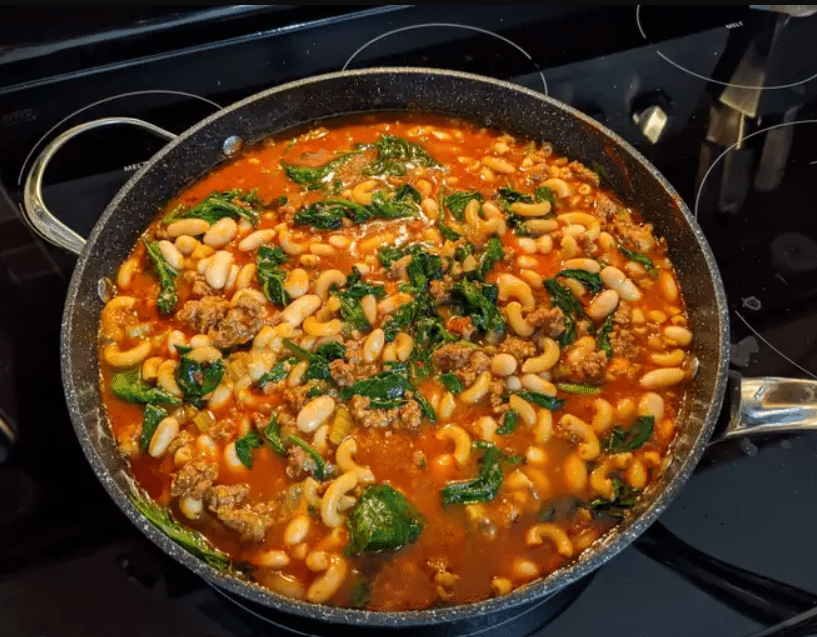Introduction :
Embarking on the journey of cooking gluten-free pasta can be a game-changer for those with gluten sensitivities or celiac disease. The rise in popularity of gluten-free diets has led to an abundance of gluten-free products on the market. Pasta, a staple in many diets, is no exception, with various gluten-free options now readily available. However, mastering the art of cooking gluten-free pasta can be a bit tricky, presenting challenges for many.
There’s a compelling story of a friend who, after being diagnosed with celiac disease, was determined to make her gluten-free pasta taste as good as the regular ones. She soon realized that it’s not just about replacing the pasta; it’s also crucial to adjust the cooking method. Consequently, this article is crafted to demystify the process, aiming to assist you in cooking perfect gluten-free pasta every time, with valuable insights from Gluten-Free Foodie’s cooking tips.
Understanding the Basics of this recipe

What Ingredients Make Up Gluten-Free Pasta?
When it comes to cooking gluten-free pasta, it’s essential to know what goes into it. Here, we break down the key components of gluten-free pasta, offering you a deeper understanding of its ingredients.
Variety of Grains
Gluten-free pasta is crafted from a variety of grains, making it distinct from traditional wheat-based pasta. These grains impart unique flavors and textures to the pasta. Let’s explore these options:
- Rice and Corn Pasta: These varieties are often mild in flavor, providing a taste similar to regular pasta. They are excellent choices when you’re looking to replicate the familiar pasta experience.
- Quinoa Pasta: This option is not only gluten-free but also packed with nutrients. It offers a slightly nuttier taste, adding a wholesome twist to your pasta dishes.
- Lentil and Chickpea Pasta: If you’re seeking a richer, buttery flavor, consider using pasta made from lentils or chickpeas. These alternatives provide a delightful taste profile that sets them apart.
Taste Differences in Gluten-Free Pasta
Understanding the nuances of gluten-free pasta’s taste is essential. While it may differ from traditional pasta, advancements in production have minimized this distinction. The taste variation depends on the grain used:
- Rice and Corn-based Pasta: These options come closest to the taste of conventional pasta, making them a popular choice for those transitioning to a gluten-free diet.
Choosing the Right Brand for Cooking Gluten-Free Pasta
When cooking gluten-free pasta, selecting the right brand can greatly influence your dining experience. Not all brands deliver the same quality. Consider the following factors:
- Brand Reputation: Look for brands with positive customer reviews and a track record of producing quality gluten-free pasta.
- Variety of Pasta Types: Opt for brands that offer a wide range of pasta types, allowing you to explore various shapes and sizes for your culinary creations.
By understanding the ingredients and selecting the right brand, you can enhance your experience when cooking gluten-free pasta and achieve delectable results in your dishes.
The Taste Difference in Gluten-Free Pasta
Indeed, gluten-free pasta does have a different taste compared to regular pasta. However, brands have made significant strides in minimizing this difference. The taste varies depending on the ingredients used, with rice or corn-based options providing a closer taste to traditional pasta.
Choosing the Right Brand for Cooking Gluten-Free Pasta
The quality of gluten-free pasta can vary significantly across different brands. Some of the top brands have excelled in producing gluten-free pasta, offering delicious options with an excellent texture. It’s beneficial to look for brands with positive customer reviews and a variety of pasta types.
Selecting the Best Gluten-Free Pasta Brand
When it comes to cooking gluten-free pasta, picking the right brand can significantly impact your culinary experience. Not all brands are created equal, and several factors should guide your choice.
Brand Reputation Matters
In the world of cooking gluten-free pasta, brand reputation is key. Look for brands with a solid track record of producing quality gluten-free pasta. Positive customer reviews can serve as a valuable indicator of brand reliability.
Variety of Pasta Types
Diversity is vital when it comes to cooking gluten-free pasta. Opt for brands that offer a wide array of pasta types, such as spaghetti, penne, or fusilli. Having options at your disposal allows you to explore different shapes and sizes for various dishes.
Certifications and Gluten-Free Labels
Pay attention to certifications and gluten-free labels on the packaging. Reliable brands often undergo testing and earn certifications to ensure their products meet strict gluten-free standards. These labels offer assurance that the pasta is safe for individuals with gluten sensitivities or celiac disease.
Customer Feedback and Reviews
Before you embark on your cooking gluten-free pasta journey, take some time to read customer feedback and reviews. This can provide valuable insights into the taste, texture, and overall quality of the pasta offered by a particular brand.
Experimenting with Brands
Don’t hesitate to experiment with different brands until you find one that aligns with your taste preferences. Every brand’s gluten-free pasta may have unique characteristics, and trying a few options will help you discover the perfect fit for your culinary creations.
By considering these factors and doing some research, you can confidently choose the right brand for cooking gluten-free pasta, ensuring that your dishes turn out delicious and satisfying.
Tips and Tricks for Cooking Gluten-Free Pasta

Avoiding Common Mistakes in Cooking Gluten-Free Pasta
Cooking gluten-free pasta demands attention to detail. Here are some common mistakes and strategies to avoid them, inspired by advice from Simply Recipes:
- Overcooking: Gluten-free pasta can quickly become mushy; start taste testing a couple of minutes before the suggested cooking time.
- Under-salting the water: Ensure the pasta water is salty; it enhances the pasta’s flavor.
- Not stirring enough: Regular stirring is crucial to prevent sticking.
- Using a small pot: Opt for a large pot to prevent boiling over and ensure even cooking.
Mastering the Art of Cooking Gluten-Free Pasta
- Diligently follow the package instructions.
- Adjust the cooking time based on the pasta’s thickness and ingredients.
- Avoid rinsing the pasta after cooking unless instructed by the package.
Exploring Gluten-Free Pasta Recipes
Dive into a world of possibilities with your gluten-free pasta. From classic tomato sauce to innovative vegetable-based sauces, there’s a plethora of options to explore. Don’t hesitate to experiment and discover what tantalizes your taste buds. For additional inspiration, check out How to Jazz Up Boring Pasta.
FAQs on Cooking Gluten-Free Pasta
Q1: Can I cook gluten-free pasta just like regular pasta?
Answer: Yes, you can cook gluten-free pasta much like regular pasta. Follow the package instructions for boiling time, but start checking a few minutes before it’s done to prevent it from becoming mushy. Make sure the water you cook it in is salty; this adds flavor to the pasta. Stir the pasta regularly while cooking to avoid it sticking together. Using a larger pot is a good idea to prevent boiling over and ensure even cooking. Remember that gluten-free pasta can be more delicate, so a little extra care in cooking will yield the best results.
Q2: Should I rinse gluten-free pasta after cooking?
Answer: Usually, you shouldn’t rinse gluten-free pasta after cooking unless the package instructions specifically recommend it. Rinsing can remove the starchy coating on the pasta, which helps sauces adhere better. If the pasta seems too starchy for your liking, you can give it a quick rinse with hot water, but do so sparingly. Ultimately, it’s best to follow the package instructions as they are tailored to that specific gluten-free pasta variety.
Q3: How do I prevent gluten-free pasta from clumping together while cooking?
Answer: To prevent gluten-free pasta from clumping together, ensure you have a large pot of boiling water. Use enough water to give the pasta plenty of space to move around. Stir the pasta regularly during cooking, especially during the first few minutes, to prevent it from sticking. You can also add a small amount of oil or cooking spray to the boiling water, which can help further prevent sticking. Following these steps will help you achieve perfectly cooked, non-clumpy gluten-free pasta that’s ready to be paired with your favorite sauces and toppings.
Q4: Can I prepare gluten-free pasta ahead of time and reheat it?
Answer: Yes, you can prepare gluten-free pasta ahead of time and reheat it, but there are a few things to keep in mind. Cook the pasta until it’s slightly underdone, as it will continue to cook when reheated. After draining the pasta, rinse it with cold water to stop the cooking process and prevent it from becoming too soft. Toss the pasta in a bit of oil to keep it from sticking together, and store it in an airtight container in the refrigerator. When you’re ready to enjoy it, simply reheat it by boiling for a short time or by microwaving it with a little water. Be cautious not to overheat, as gluten-free pasta can become mushy if overcooked during reheating.
Wrapping Up Your Journey in Cooking Gluten-Free Pasta
In wrapping up our exploration of cooking gluten-free pasta, it’s clear that this culinary journey is teeming with possibilities. Embrace the process of learning and experimentation as you venture into the realm of gluten-free pasta.
Transitioning to a gluten-free diet due to sensitivities or celiac disease doesn’t mean sacrificing the joy of pasta dishes. With the right ingredients, cooking techniques, and brand choices, you can create delectable gluten-free pasta dishes that rival their traditional counterparts.
Remember to consider the variety of grains, taste differences, and the importance of choosing reputable brands. These elements, coupled with the tips and tricks provided, will empower you to cook perfect gluten-free pasta every time. So, embark on this flavorful voyage, explore a world of gluten-free pasta recipes, and savor the delicious possibilities that await. Happy cooking!. For additional pasta recipes and tips, feel free to explore Omega Recipes.

